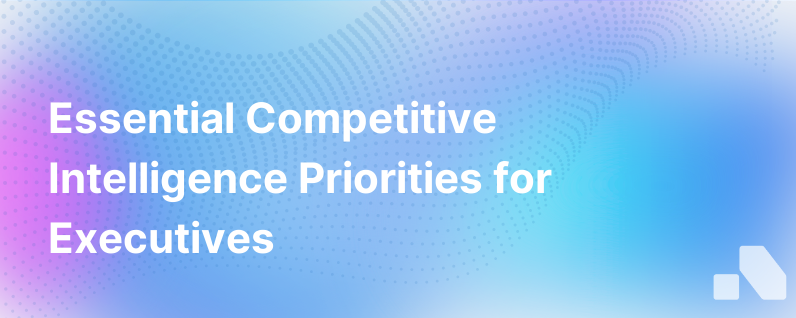Competitive Intelligence Priorities
Published on December 24, 2023 by David Zhang
Competitive intelligence is pivotal in the fast-paced world of business. However, the challenge lies in filtering and managing the onslaught of information about your competitors effectively. As such, setting up competitive intelligence priorities is crucial for maintaining nimbler and more insightful business operations.
This article will take you through the underpinning principles of designing competitive intelligence priorities, why they matter, and how to set them effectively.
Understanding Competitive Intelligence Priorities
Competitive intelligence is a systematic methodology of collecting and analyzing information about your competitors to make better strategic decisions. Meanwhile, competitive intelligence priorities is the process of organizing these methodologies.
Competitive intelligence priorities are not static; they're dynamic and shift according to the changing business landscape, marketplace trends, and company goals. They are not a one-size-fits-all process, but are tailored specifically to the needs of your organization.
The Importance of Competitive Intelligence Priorities
Sound competitive intelligence priorities help businesses stay proactive rather than reactive. Here's why they matter:
A Clearer Decision-Making Process: Prioritizing competitive data gives clarity in the decision-making process by eliminating unnecessary noise and focusing on what matters most.
Informed Strategic Planning: With specific competitive data at their fingertips, businesses can make informed strategic choices about growth, expansion, and innovation.
Proactive Problem-Solving: Priorities help businesses identify potential issues before they become larger problems. They enable companies to implement solutions sooner, thereby avoiding major disruptions to operations.
Identifying Opportunities: Setting competitive intelligence priorities can help pinpoint opportunities in the market, whether this means capitalizing on a competitor's weakness or identifying a gap in the market.
The 5 Fundamental Priorities You Can't Ignore
Sure, every business is unique, but robust competitive intelligence priorities generally pertain to the following key areas:
-
Elemental Business Data: This base layer of competitive intelligence includes essential details about your competitors - annual reports, product portfolio, business model, etc. Monitoring this data provides a window into competitors' current state and potential future actions.
-
Market: Understanding the market in which your competitors operate is crucial. Are they expanding into new regions? What is their market share? Where are their customers based?
-
Innovation: Keep tabs on their product development and innovation. New patents, product expansions, or service enhancements can signal future direction.
-
Competitor's Customers: What types of customers are they attracting? Analysing customers reviews and feedback can offer valuable insights into your competitors' strengths and weaknesses.
-
Financial Performance: A competitor's financial health, liquidity, and profitability provide a robust picture of their capacity to invest in growth, innovation, or expansion.
Each of these priorities offers different insights. Therefore, it’s not a question of selecting one over another; instead, concentrate on all of these to paint a comprehensive picture of your competition.
Developing Effective Competitive Intelligence Priorities
Formulating effective competitive intelligence priorities requires businesses to:
Understand their Competitive Landscape: Size up your competition. Identify who your direct and indirect competitors are. This will allow you to customize your priorities accordingly.
Determine Critical Factors for Success: What aspects of your business are likely to be impacted by competition? Customer acquisition? Product life cycle? Identify these factors and build your intelligence priority around them.
Set S.M.A.R.T Goals: Make your priorities Specific, Measurable, Achievable, Relevant, and Time-bound. A SMART framework allows for a more meaningful approach to competitive intelligence.
Leverage Technology: Technologies like AI-powered platforms, such as Aomni, can extract the most relevant and necessary competitive intelligence, tailored to your specific business requirements.
Continually Review and Update: Just as competition evolves, so should your competitive intelligence priorities. Regularly review and refine your priorities to remain accurate and relevant.
Conclusion
The foundation of successful business decision-making lies in the quality of its competitive intelligence. Prioritizing your competitive intelligence effectively ensures that data overload doesn't cloud your insight. Instead, it allows for pinpoint precision in strategy, planning, and execution, achieving a competitive advantage.
Regardless of the size of the company, dedicating time and resources to competitive intelligence priorities is a sure-fire way to stay ahead of the competition. Implementing stringent yet flexible priorities can mean the difference between playing catch-up and leading the pack.
Fortunately, platforms like Aomni can help streamline these processes, using AI to generate real-time, relevant, and personalized intelligence, tailored to your specific business priorities in a fraction of the usual time and effort.